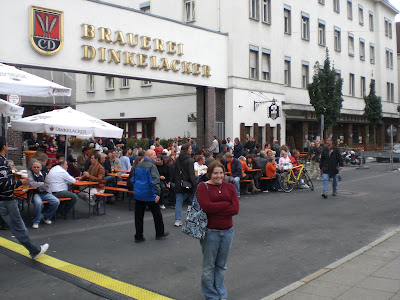This weekend was a typical German fall weekend. Nights are extremely cold, I even slept with flannel pj bottoms and a sweathshirt last night (we still have the bedroom window open.) Yesterday, it was grey and rainy most of the day. Today, we had sun and clouds, but the temperature has failed to reach even 60°F. I feel that we are ushering my favorite season, Sweater season!
In Germany, fall is also loaded with fests. In the summer, Germans prefer biergartens, but fall through spring is heavy fest time. Unfortunately, we missed the Stuttgart Weindorf (Wine Village,) which I feel is really the beginning of fall. But today, we got to another fest, and it served it's purpose, to give me the true sense of saying "goodbye" to summer, and saying "welcome" to fall.
This afternoon, we went to the Dinkelacker- Schwaben-Bräu Brauerifest, a brewery fest held by Dinkelacker-Schwaben-Bräu, two major names in the Baden-Wuerttemberg beer scene.
 The fest itself was quite large, and encompassed the majority of the brewery grounds. Dinkelacker- Schwaben-Bräu is the largest brewery in our state, and it is also the largest privately owned brewery in the area. We learned in our brewery tour, which I will touch on later, that the brewery had been bought over by Inbev/ Interbrew (Budweiser, Spaten, St. Pauli Girl, Labatt...). But, in 2007 investors worried that the quality of the product would be betrayed through the larger corporation, and bought back the brewery. It is now private, and one of the strongest breweries in the area, which can be difficult coming up against larger beverage conglomerates.
The fest itself was quite large, and encompassed the majority of the brewery grounds. Dinkelacker- Schwaben-Bräu is the largest brewery in our state, and it is also the largest privately owned brewery in the area. We learned in our brewery tour, which I will touch on later, that the brewery had been bought over by Inbev/ Interbrew (Budweiser, Spaten, St. Pauli Girl, Labatt...). But, in 2007 investors worried that the quality of the product would be betrayed through the larger corporation, and bought back the brewery. It is now private, and one of the strongest breweries in the area, which can be difficult coming up against larger beverage conglomerates.The entry road to the fest was lined with various cars that had starred in the parade, that we, sadly, missed. Besides different vehicles used for advertising both Schwaben-Bräu and Wulle Bier (an old brand bought over by Dinkelacker and making a comeback,) there was a very old Audi precursor, and an old Jaguar on display.

Joern and Marcel, always up for something new decided that once they entered the fest, they would try some Wulle Bier. We later learned in the tour that Wulle Bier was originally created for women, as a less bitter beer. Joern and Marcel weren't phased, and felt that it was quite sexist, they really enjoyed the beer.

There were also events for kids, like this keg rolling race.

There was even a sample satation. Joern and Marcel decided against this as the line was the longest at the event. Afterall, beer is the national drink and free is one word that attracts the attention of Swabians like none other.

Of course, this fest was not just about beer. There is always a food component. Since it was so late, and we hadn't eaten lunch, we decided on a snack/dinner. Joern had a pork steak with fried onions, Marcel had my favorite, rolled potato noodles and sauerkraut. I had a wurst, but couldn't take a picture of myself. Naturally, all food was washed down with the boys' new favorite, Wulle Bier.

Since the brewery isn't always open to the public, it was enjoyable to walk around and take in the very large size of the brewery compound.

We had to wait a short while to enter the actual brewery. The tour was in three separate buildings, and we went first to the place where the beer is actually brewed. In the very large tanks inside, malt, hops, and pure Lake Constance water, are mixed together and heated to create the brew. It is the actual brewery that is responsible for the characteristic brewery smell in the air near Dinkelacker.

After the brewery, we went to the storage building. This, to me, was most interesting. There was also most to see. The storage buidling consists of 39 stainless steel cylindrical tanks, each 78 feet high. It is inside these cylinders that the actual fermentation process takes place, and the brewed ingredients become alcohol. The total volume of all the containers is about 2.6 million gallons of fermenting beer. We also saw the central processing unit, where oats are added to some tanks to make Hefe-Weizen. It is also in the central processing unit where all of the extra carbon-dioxide produced by the fermentation process is sent to a different area. There are so many pipes and so many outlets. Our tour guide told us that because of the German Purity Law, all additives, such as oats, spices, etc, must be kept and added separately, and that Germany is the only country to do this. This makes for many, many pipes and outlets. It was quite amazing and intricate.

Before heading to the keg filling area, we stopped at the historical exhibit of old advertisements from the various beers owned by Dinkelacker-Schwaben-Brau. The exhibit was in the employee cafeteria. Marcel got really jealous when he found a beer machine next to the coffee and soft drink machines for the workers.

Our last stop was the keg-filling area. There was no tour, but you could see the automated process by which kegs are filled, and the robotic arms that move the kegs on and off conveyor belts.

Keine Kommentare:
Kommentar veröffentlichen